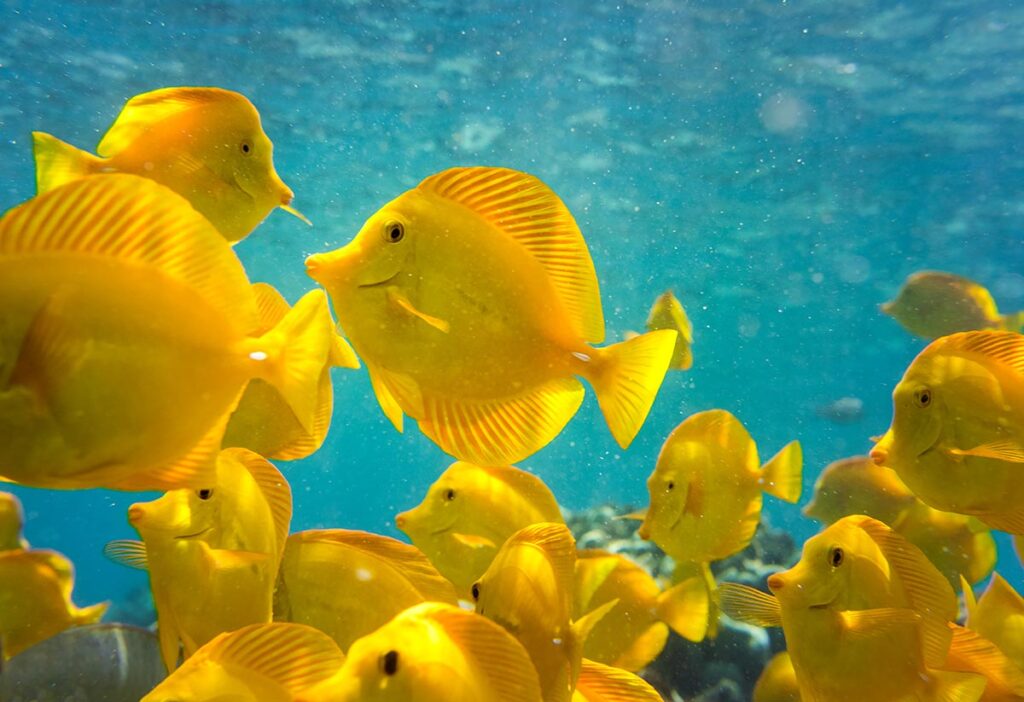
Anti-aquarium advocates continue to push for the closure of the so-called “AQ” (aquarium) fishery in Hawai’i. A new court ruling puts increased pressure on state authorities to tighten the renewal of fishing permits, which are currently frozen at just 41, while no new licenses can be issued until a major environmental review is completed.
CORAL Magazine staff will continue to monitor and report on this latest breaking news in the ongoing legal battle over Hawaii’s marine aquarium fishery. Watch our social media channels, emails, and this space for additional information as it becomes available.
A tangle of nets and red tape
In 2017, the Hawaii State Supreme Court overturned lower court decisions, issuing a ruling that invalidated permits explicitly issued for the collection of aquarium fishes with fine-mesh nets, and ultimately mandating an environmental impact statement to be prepared and accepted under Hawaii Environmental Policy Act (HEPA). The ramifications of this ruling made the use of these nets illegal, closed certain fishing locations, but did not entirely block the fishery for marine aquarium fishes in the state.
While some fishermen left the fishery, others adjusted their practices to comply with current laws, resulting in a reduced, but still active fishery. Prices on Hawaiian fishes increased in the aquarium trade. The general commercial marine fishery license (CML) allowed these fishermen to continue fishing.
Now, a November 27, 2020, Hawaii First Circuit Court ruling has determined that even under the general CML, the aquarium fishery is subject to the same environmental review requirements. While not closing the fishery immediately, the DNLR is prevented from issuing new permits or renewing existing ones.
Meanwhile, under the leadership and great financial expense incurred by the Pet Industry Joint Advisory Council (PIJAC), the environmental impact statement process had started. Draft EIS documents were issued in 2019. Then, finalized EIS documents were submitted for review, only to be dismissed by the state’s Board of Land and Natural Resources (BLNR). Fishermen issued urgent pleas for help.
This decision brought strong condemnation from 21 Ph.D.-credentialed biologists, who collectively called BLNR actions “distressing and demoralizing” noting that the decision was clearly “not based on the best available science and relevant monitoring data.” These scientists dispute the BLNR statements, clearly charging that “There is a huge amount of data and other information showing that the aquarium fishery is sustainably managed and that the system works.”
In no uncertain terms, these scientists endorsed and supported Hawaii’s marine aquarium fishery as the benchmark against which other fisheries ought to be compared, writing “This type of science-based management should be a model for other fisheries in Hawaii.” [emphasis added]
Read the full response of leading marine biologists in Hawai’i: https://www.westhawaiitoday.com/2020/06/25/opinion/my-turn-we-expect-better/
The future of Hawaii’s marine aquarium fishery is more uncertain than ever. PIJAC has recently issued fundraising requests surrounding this ongoing battle over the fishery. Unless or until an EIS is accepted and approved, Hawaii’s embattled marine aquarium fishery is currently on a trajectory of forced obsolescence despite overwhelming scientific support and demonstrable sustainability.
The DLNR’s response to the latest court filing follows.
via Hawaii Department of Land and Natural Resources (DLNR)
DLNR RESPONSE TO LATEST COURT RULING ON AQUARIUM FISHING IN HAWAI‘I
(HONOLULU) – The Department of Land and Natural Resources is taking immediate steps to comply with a new order issued late Friday from the First Circuit Court, requiring Chapter 343 environmental review for issuance of new or renewed annual commercial marine licenses (CMLs) to be used for aquarium fishing purposes under HRS 189-2.
This is in addition to the Hawaiʻi Supreme Court’s 2017 ruling requiring Chapter 343 environmental review for issuance of fine-mesh net permits used for aquarium fishing under HRS 188-31. “The court agrees with DLNR that Umberger did not specifically address or resolve the issue of whether HRS 189-2 permits are an “action” for purposes of HEPA.”
Immediately, the DLNR Division of Aquatic Resources (DAR) will not renew or issue new CMLs without a condition prohibiting the taking of marine life for aquarium fishing purposes until Chapter 343 environmental review is completed. 41 commercial marine licensees of the approximate 3,000 CMLs currently report aquarium catch.
The court declined to issue an injunction at this time stopping aquarium fishing under existing CMLs, which are issued for a year at a time. “The court therefore declines to issue an injunction at this time, without prejudice. Plaintiffs may file a further motion requesting injunctive relief if they so choose.”
The court recognized that an immediate ban would “cause economic hardship to aquarium fishers, their families, employees, and vendors” particularly now, during the pandemic.
DLNR Director Suzanne Case pointed to several high-profile aquarium fishing enforcement busts on Hawai‘i island this year that were the result of tips from concerned community members. These cases are still in the courts and DLNR civil violation systems. In the meantime, DLNR is encouraging anyone who suspects illegal aquarium fishing to report it immediately to the DLNR 24-hour violation hotline or via the free DLNRTip app. “We continue to take illegal aquarium fishing seriously. We want people to continue to report any illegal activity,” Case said.
###





Well Rene Umberger and Snorkle Bob have won. A fishery more studied than most Alaska fisheries will be dead in 12 months when all permits run out.
No more bandits, achillies, pretty Hawaiian fish found nowhere else
Sad
Auwe
Aloha
I visit your website its information is to the point and informative for us. If you get more information please visit our webpage Allinformative.com its all about real information. I hope you get more and related information about your keyword on my Website.
this is bulcrap law from hawaii. wait till virus ban lift aquarium fish will resume around the world. do not care about hawaii law idiots